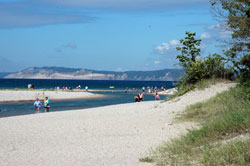Vacation/Travel Supplement
Do the dunes:
Enjoy beaches on Lake Michigan’s eastern shoreline

Platte River flows into Lake Michigan at Sleeping Bear Dunes National Lakeshore. The shallow, sandy bottom of the riverbed makes it fun for tubing.
By Mary Ann Wyand
LAKE MICHIGAN PARKS—Climb a dune. Splash in the water. Build a sand castle. Fly a kite. Share a picnic lunch. Watch the boats go by. Gaze at the shoreline. Remember to use sunscreen.
Just don’t bury your nose in a book and miss the magnificent views or fall asleep on the beach and get sunburned while vacationing at state and national parks along Lake Michigan’s eastern shoreline.
The western border of Michigan—the Great Lake’s eastern shoreline—is home to dozens of large dunes from Tower Hill at Warren Dunes State Park in the south to Pyramid Point at Sleeping Bear Dunes National Lakeshore in the north.
Children will love the mammoth Tower Hill at Warren Dunes. It’s best to climb dunes in the morning before the midday sun makes the sand too hot to walk on barefoot. Shoes fill with sand, and you have to dig your toes into the dune to get a good grip on the slippery slope.
If you get tired of the sun, nearby New Buffalo, Mich., is home to Redamak’s, famous for mouth-watering hamburgers since 1975, as well as ice cream shops, fruit stands, antique stores and boutiques.
Heading north up the shoreline, Muskegon State Park has smaller dunes but boasts a beautiful two-mile-long beach and great camping facilities.
If you haven’t reserved a campsite on their Web site yet, chances are you will have to wait until April 2008 to register online to pitch a tent or park a recreational vehicle there next summer. The good news is you can enjoy the public beach for day outings this year.
Muskegon State Park is also close to Michigan’s Adventure amusement and water park. A day spent there riding six roller coasters and skimming down lots of water slides will make the kids happy.
Also nearby is the Great Lakes Naval Memorial and Museum, which features tours of the U.S.S. Silversides, a decorated and retired Navy submarine from World War II, and the U.S. Coast Guard’s McLane, both moored in the channel.
That’s a great place to watch big ships dock at the Muskegon harbor and get a feel for maritime life at a lighthouse.
Driving further north for about two hours on U.S. 31 takes you to Sleeping Bear Dunes National Lakeshore on Michigan’s Lower Peninsula. You can easily spend a week there.
The Philip A. Hart Visitor Center on
M-72 in Empire, Mich., is open every day and park rangers or volunteers will answer all your questions about the 35-mile national lakeshore with world-class vistas.
Like most Lake Michigan parks, campsites fill up quickly with summer reservations made as early as April. But early morning arrivals—think sunrise—can get lucky at the national lakeshore’s
D. H. Day or Platte River campgrounds.
But be prepared to camp elsewhere or find lodgings near Leland, Mich., or another nearby town as a last resort.
If you only have a few days, be sure to go tubing on the Platte River, a sandy waterway that flows into Lake Michigan. There is a public beach with parking fee.
Also enjoy the beach at Sleeping Bear Point near Glen Haven, Mich., where you can tour a U.S. Coast Guard Museum and read accounts of heroic water rescues in the treacherous Manitou Passage.
Drive to Leland, Mich., and take the ferry to South Manitou Island if you have extra cash because it’s fun to look at the lighthouse there up close, hike the island and discover the shipwreck on the opposite shore. Watch the time so you don’t miss the ferry ride back to Leland. If you’re late and miss the boat, you get to stay overnight on the island.
Sleeping Bear’s famous Pierce Stocking Scenic Drive gives visitors incredible views of the Lake Michigan shoreline, Glen Lake and dozens of really big dunes, of course, and attracts tourists from all over the world.
A few years ago, a huge chunk of magnificent Pyramid Point—one of Sleeping Bear’s largest dunes—succumbed to erosion and fell into the lake. Known as “sloping,” the massive avalanche carried trees three miles out into Lake Michigan.
It’s safe to hike up to Pyramid Point, but don’t let the kids climb down the steep incline left by the sloping. You can see North and South Manitou Islands from the top of the dune, possibly a freighter in the distance and will remember this incredible view forever.
(For information about Lake Michigan beaches, log on to www.michigan.org and www.nps.gov/slbe.) †
